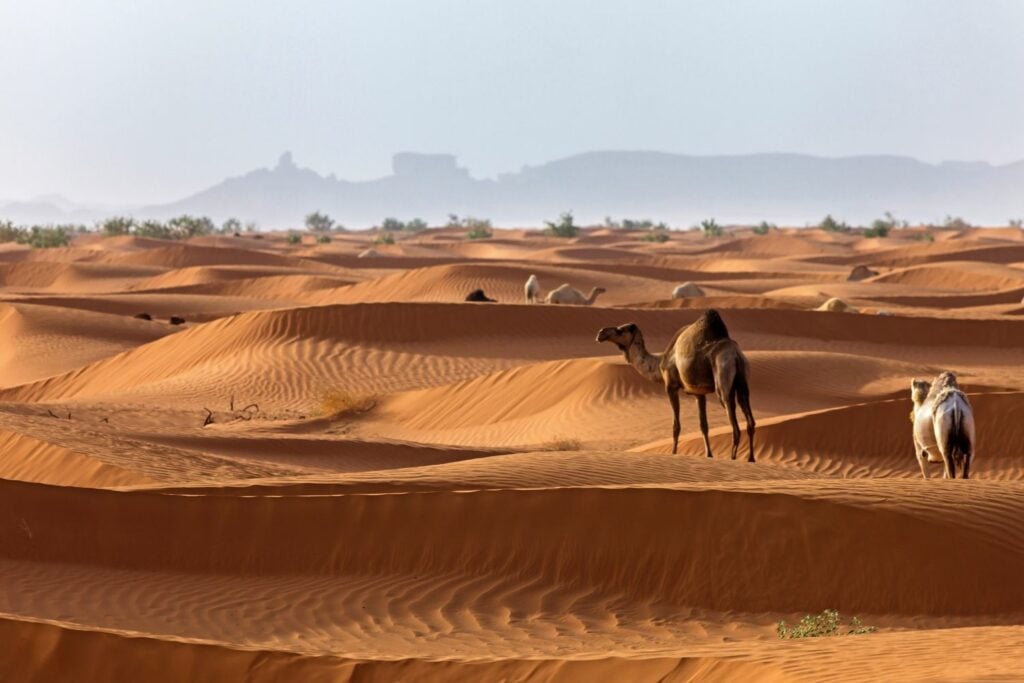The Sahara Desert is located on the African continent. It is the world’s largest hot desert, with an area of 9,200,000 square kilometers, and the third-largest desert overall, slightly smaller than the deserts of Antarctica and the northern Arctic. But did you know that the Sahara desert used to be a rainforest?
Around 6,000 years ago, the Sahara Desert, known as the world’s hottest desert, was a lush rainforest.
The Green Sahara of the Past
Evidence from various sources indicates that the climate of the entire Sahara region was considerably different only a few thousand years ago. According to animal bones found in the dry sands, giraffes and elephants formerly wandered where there was no vegetation or water. The people who lived in the middle Sahara at the time even chronicled the creatures they observed in rock carvings and engravings, demonstrating how drastically this environment has altered in just a few thousand years. Pollen preserved in the dried mud of historic lake beds and empty river channels provides a complete image of the terrain at the time.
It exposes a mix of scrublands, open forests, and grasslands, with plant species that can currently only be found hundreds of kilometers south. Even the Sahara’s extremely arid core, which now receives less than 25 mm of rainfall per year, had a dense plant cover capable of supporting cattle-herding and localized wheat-growing. All data indicates that the moistness of the Saharan environment at the time much outweighed the alternative green Sahara state of the modern world. To distinguish it from the just green Sahara, we should respect the legacy of this remarkable period in climate history with the upper case Green Sahara. (Source: Climate Policy Watcher)
What was the Sahara Desert 6,000 Years Ago?
The Sahara desert collected from pollen, animal fossils, and ancient lake deposits demonstrates that the old Green Sahara phase lasted from around 9,000 to 6.000 years ago, followed by a slowing reduction in rainfall to reach virtually the current state of aridity by 4,000 years ago. So, when the earliest organized communities emerged in Egypt around 6,000 years ago, the environment beyond the Nile Valley may have looked very different from what it does now. The terrain in which the great pyramids were created 4,500 years ago was likely not the bare sand that remains today.
Instead, there would have been little plants and grass scattered across the landscape, perhaps a few feet apart. As a result, the environment the pyramid builders viewed around them was quite different, possibly providing a better contrast to the yellow limestone of the pyramids themselves. Some archaeologists believe that the initial trigger that began the phase of monument-building by the ancient Egyptian culture was the beginning. (Source: Climate Policy Watcher)
How Hot is The Sahara Desert?
The Sahara is the world’s hottest desert, having one of the harshest temperatures. The average yearly temperature is 30°C, with the highest recorded temperature being 58°C. The region receives minimal rain; half of the Sahara Desert gets less than an inch of rain yearly.
Despite popular belief, temperatures in the Sahara drop drastically at night due to a lack of humidity and can reach lows of -6°C. Snow falls on many mountain ranges regularly but nowhere else in the Sahara. (Source: Global Adventure Challenges)
Image from Treehugger
